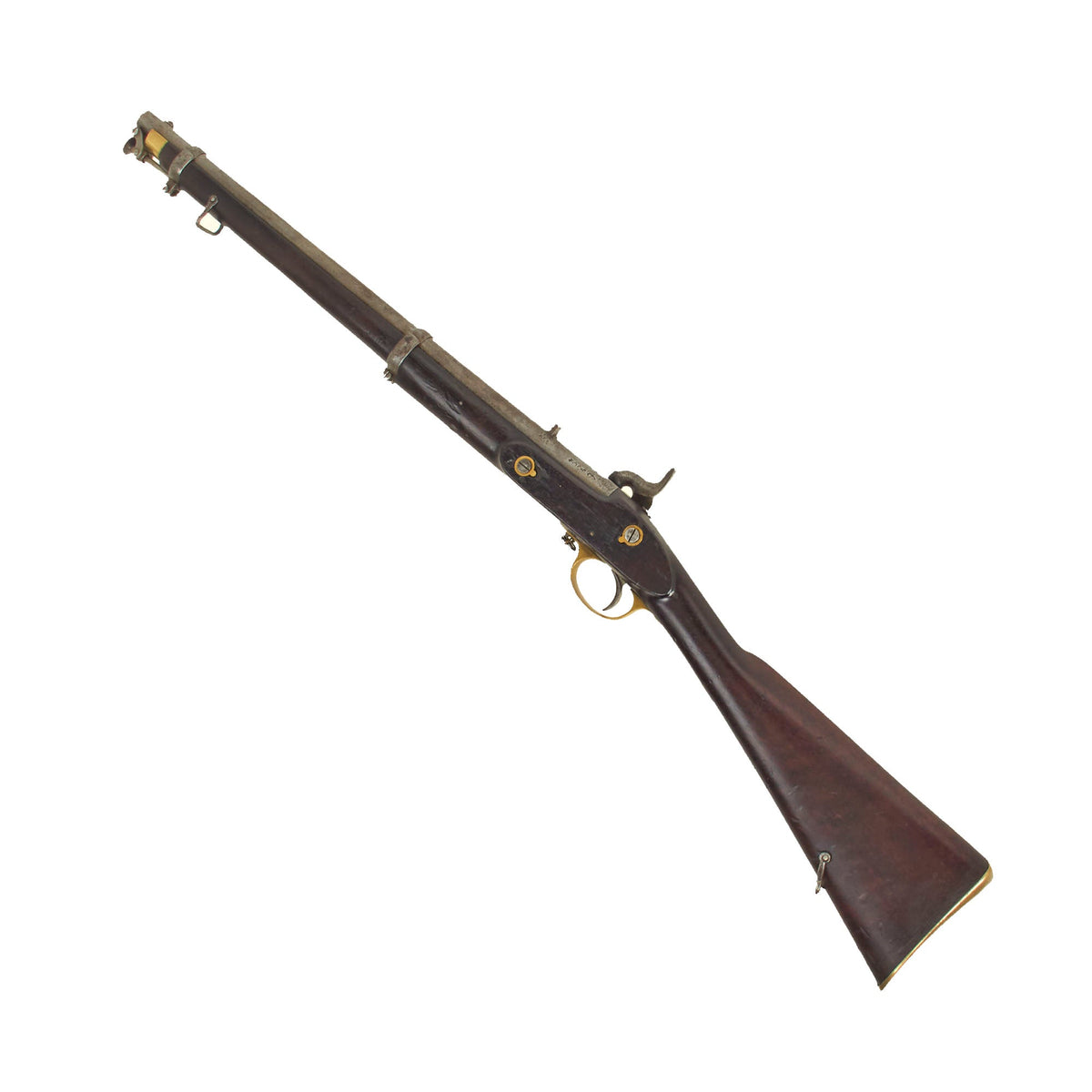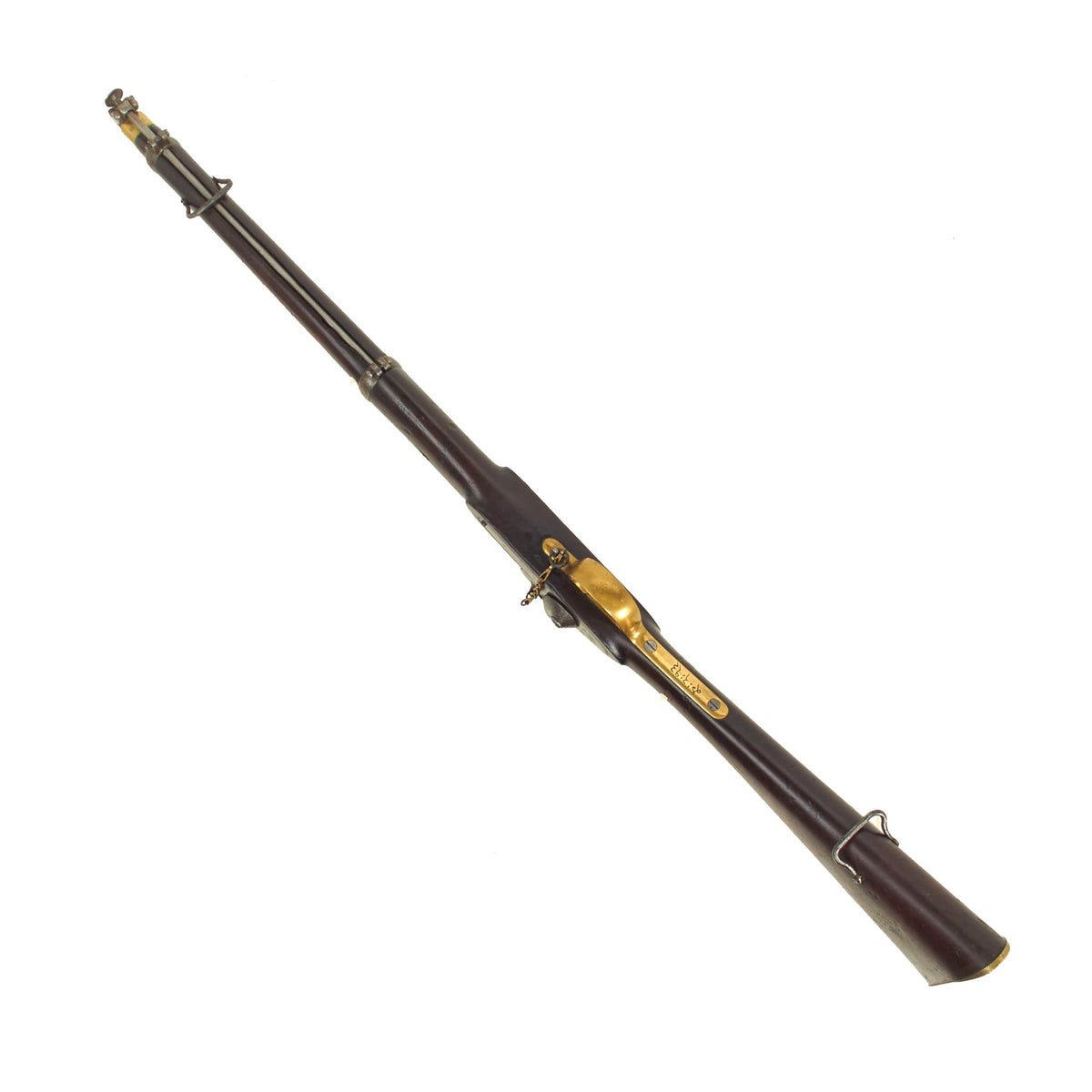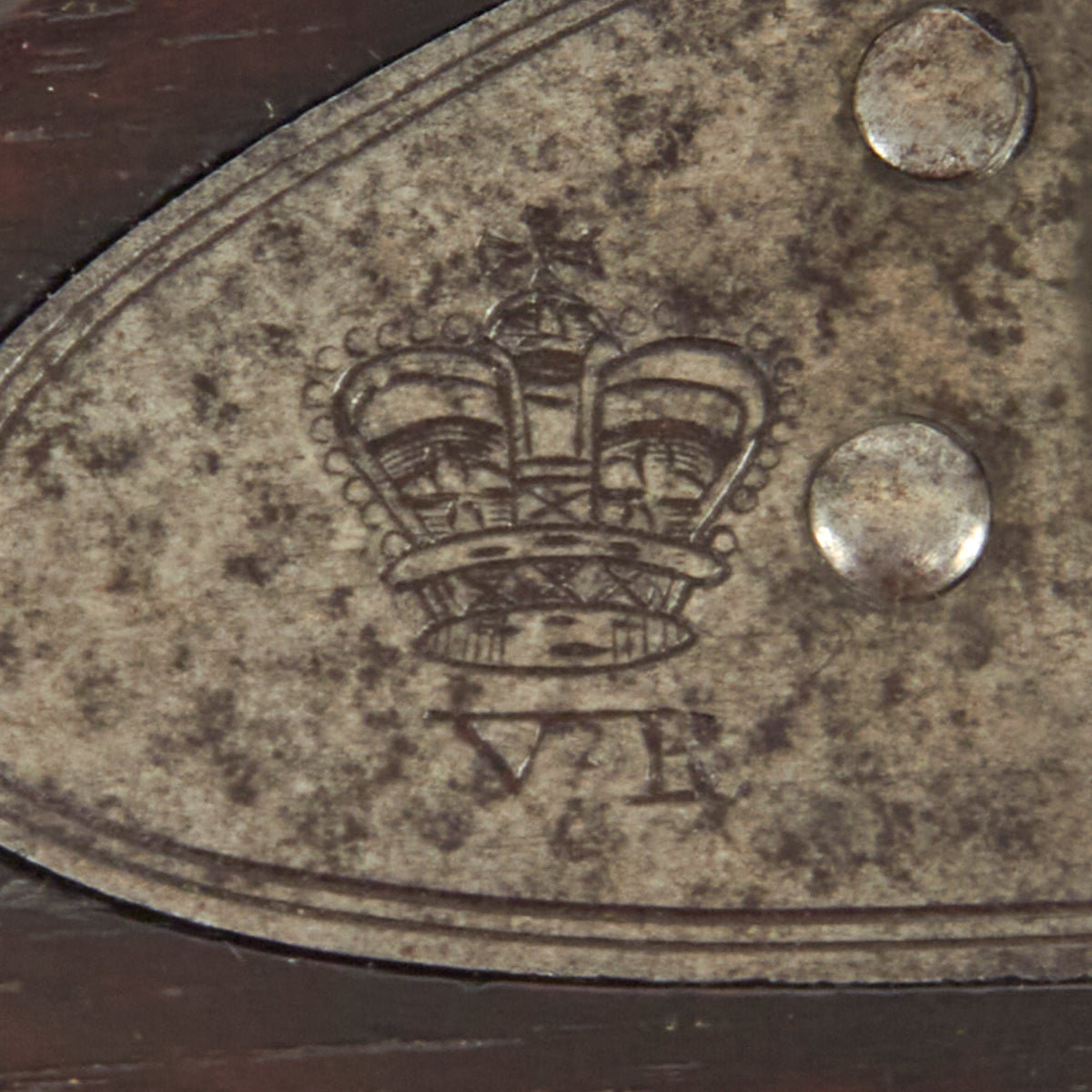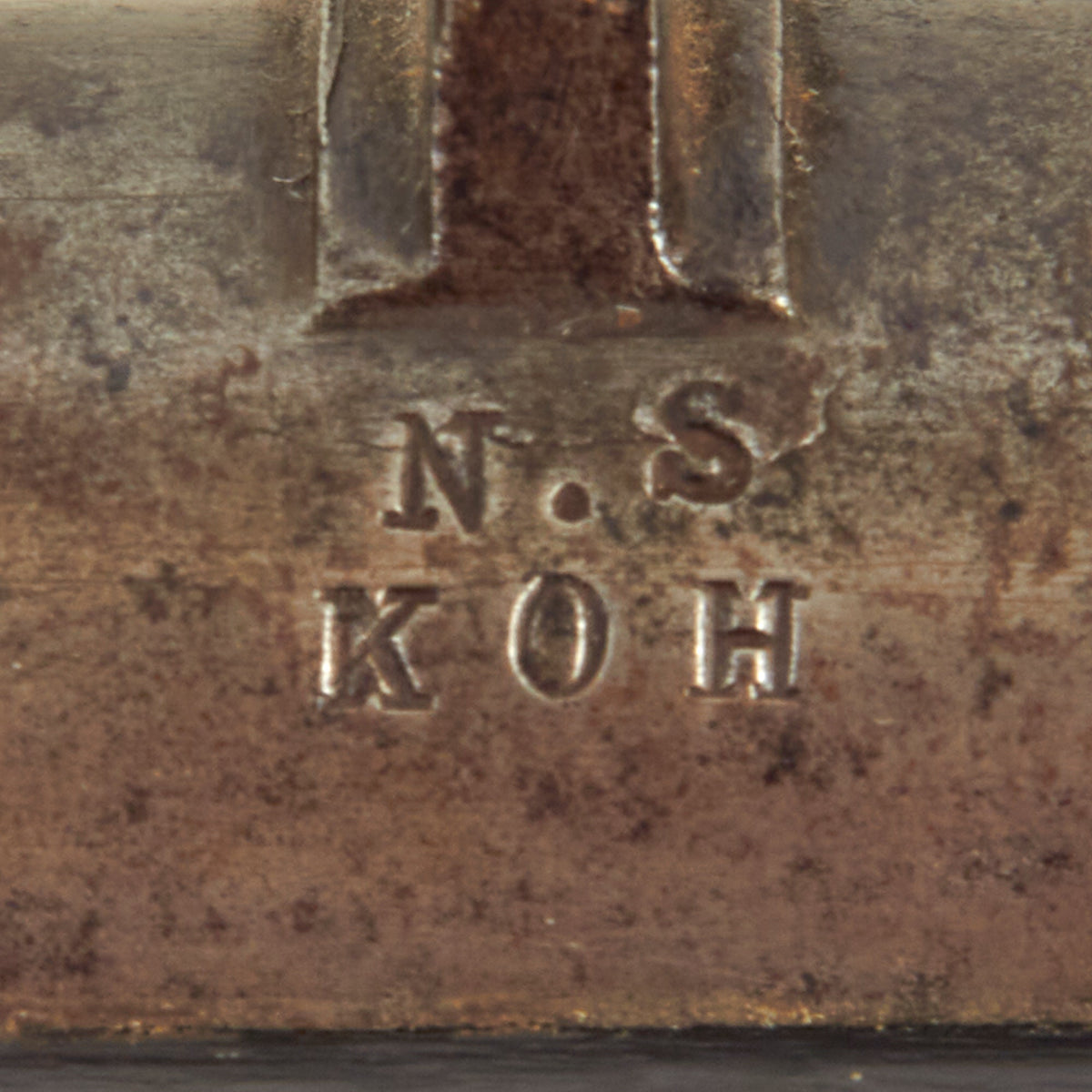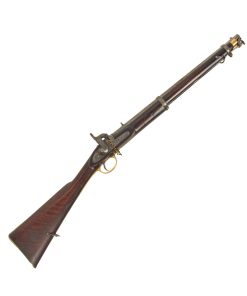Original British Victorian P-1856 Tower “East India” Percussion Cavalry Carbine with Bombay Arsenal Markings – dated 1857 Original Items
$ 1.495,00 $ 373,75
Original Item: Only One Available. Just purchased at a local military show, this is a very interesting example of a British Pattern 1856 “East India Pattern” Cavalry Carbine, part of the famous P-1853 Enfield lineage of rifled muzzleloaders. As the name indicates, these were intended for cavalry use in the Indian subcontinent during the Victorian era, and were produced with a “captured” swivel ramrod with a large Palm-plate tip, as well as a sling bar with sliding rings on the left side. They also originally had three groove rifling, and a folding leaf rear right.
This example is in very good condition, and is marked 1857 / TOWER on the lock plate under the percussion bolster, indicating production / acceptance in 1857 at the tower arsenal. The lock plate tail has the correct CROWN / V.R. marking for Queen Victoria, as well as the CROWNED BROAD ARROW lock viewer’s mark to the right of the date. There is also a CROWN / 21 proof mark on the lock plate as well.
The barrel bears many additional proof markings, including the CROWN / GP gunmakers proof (faint) and numerous others. Most important of these however are definitely the N.S / KOH by the rear sight and “Opposed Broad Arrows” B A marking on top of the nocks form, which are markings from India, then under British control. The first is a “Native State” marking, possibly from “Kohat” or “Kolhapur”, while the second indicates it was moved out of British Service and accepted at the Bombay Arsenal. There is an additional B A marking on the right side of the butt stock, as well as an intact and legible BOMBAY ARSENAL rondel stamp. We very rarely get examples with such great markings and research potential!
The carbine stays relatively true to the pattern, and has a 21″ barrel with the “captured” swivel ramrod still intact, and an overall length of 36 1/2 inches. However, the saddle ring bar has been removed, and standard escutcheons put in place, with the correct protrusions where the inlets for the bar used to be. It has had sling swivels fitted, and the rear sight replaced with a simple fixed sight. Most importantly, the barrel has been “smooth bored” to about .66 caliber for use AFTER the Sepoy Rebellion, more commonly known as the Indian Mutiny of 1857 to 1859.
Overall condition is very good, and this really is a great example with lots of history, which has not been excessively cleaned. It still has a fantastic patina and markings, sure to delight any collector of Victorian British arms. The metalwork shows an aged gray patina with some light peppering, and the stock has a lovely dark red brown color. It shows the usual dents and wear from age and service, with the only notable crack being one running forward from the trigger guard. It has fantastic grain, with a lot of tiger “flame” figuring in the butt stock.
The sling swivels are present and in good shape, having been added after the saddle bar was removed. The lock is fully functional, holding at half cock and firing at full. There is even a chained nipple cone protector, though we suspect it is not original to the piece.
A lovely Victorian Percussion carbine, ready to research and display!
Specifications:
Year of Manufacture: 1857
Bore Diameter: About 0.66 inches
Ammunition Type: Lead Ball & Powder with Percussion Cap
Barrel Length: 21 inches
Overall Length: 36 1/2 inches
Action: Side Action Percussion
Feed System: Muzzle-Loaded
NOTE: International orders of antique firearms MUST be shipped using UPS WW Services (courier). USPS Priority Mail international will not accept these. International customers should always consult their country’s antique gun laws prior to ordering.
Fast Shipping with Professional Packaging
Thanks to our longstanding association with UPS FedEx DHL, and other major international carriers, we are able to provide a range of shipping options. Our warehouse staff is expertly trained and will wrap your products according to our exact and precise specifications. Prior to shipping, your goods will be thoroughly examined and securely secured. We ship to thousands clients each day across multiple countries. This shows how we're dedicated to be the largest retailer on the internet. Warehouses and distribution centres can be located throughout Europe as well as the USA.
Note: Orders with more than one item will be assigned a processing date depending on the item.
Before shipping before shipping, we'll conduct a thorough inspection of the items you have ordered. Today, the majority of orders will be delivered within 48 hours. The delivery time will be between 3-7 days.
Returns
The stock is dynamic and we cannot completely manage it because multiple stakeholders are involved, including our factory and warehouse. So the actual stock may alter at any time. It's possible that you may not receive your order once the order has been made.
Our policy is valid for a period of 30 days. If you don't receive the product within 30 days, we are not able to issue a refund or an exchange.
You can only return an item if it is unused and in the same state as the day you received it. You must have the item in its original packaging.
Related products
Uncategorized
Uncategorized
Angolan Rebel 1970s era 60mm Inert Display Mortar from Angolan Civil War Original Items
Uncategorized
Uncategorized
Uncategorized
Uncategorized
Uncategorized
Uncategorized
Uncategorized
Uncategorized
Armoured Fighting Vehicles of the World: AFVs of World War One (Hardcover Book) New Made Items
Uncategorized
Australian WWII Owen MK1 Machine Carbine SMG Custom Fabricated Replica with Sling Original Items
Uncategorized
Uncategorized
Band of Brothers ORIGINAL GERMAN WWII Le. F.H. 18 10.5cm ARTILLERY PIECE Original Items
Uncategorized
Uncategorized
Uncategorized
Uncategorized
Uncategorized
Uncategorized

